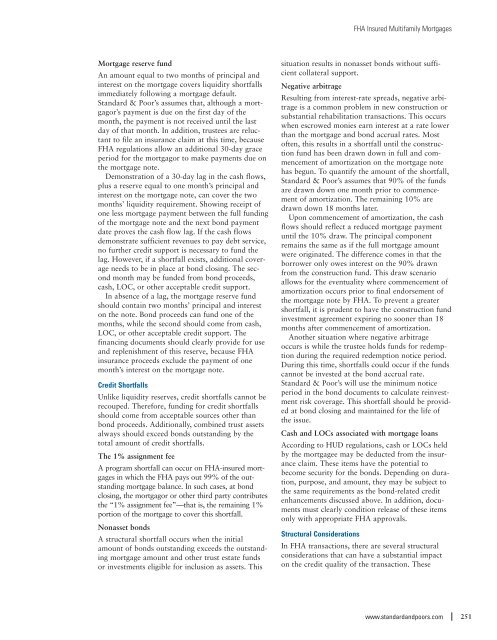S&P - Public Finance Criteria (2007). - The Global Clearinghouse
S&P - Public Finance Criteria (2007). - The Global Clearinghouse
S&P - Public Finance Criteria (2007). - The Global Clearinghouse
Create successful ePaper yourself
Turn your PDF publications into a flip-book with our unique Google optimized e-Paper software.
FHA Insured Multifamily MortgagesMortgage reserve fundAn amount equal to two months of principal andinterest on the mortgage covers liquidity shortfallsimmediately following a mortgage default.Standard & Poor’s assumes that, although a mortgagor’spayment is due on the first day of themonth, the payment is not received until the lastday of that month. In addition, trustees are reluctantto file an insurance claim at this time, becauseFHA regulations allow an additional 30-day graceperiod for the mortgagor to make payments due onthe mortgage note.Demonstration of a 30-day lag in the cash flows,plus a reserve equal to one month’s principal andinterest on the mortgage note, can cover the twomonths’ liquidity requirement. Showing receipt ofone less mortgage payment between the full fundingof the mortgage note and the next bond paymentdate proves the cash flow lag. If the cash flowsdemonstrate sufficient revenues to pay debt service,no further credit support is necessary to fund thelag. However, if a shortfall exists, additional coverageneeds to be in place at bond closing. <strong>The</strong> secondmonth may be funded from bond proceeds,cash, LOC, or other acceptable credit support.In absence of a lag, the mortgage reserve fundshould contain two months’ principal and intereston the note. Bond proceeds can fund one of themonths, while the second should come from cash,LOC, or other acceptable credit support. <strong>The</strong>financing documents should clearly provide for useand replenishment of this reserve, because FHAinsurance proceeds exclude the payment of onemonth’s interest on the mortgage note.Credit ShortfallsUnlike liquidity reserves, credit shortfalls cannot berecouped. <strong>The</strong>refore, funding for credit shortfallsshould come from acceptable sources other thanbond proceeds. Additionally, combined trust assetsalways should exceed bonds outstanding by thetotal amount of credit shortfalls.<strong>The</strong> 1% assignment feeA program shortfall can occur on FHA-insured mortgagesin which the FHA pays out 99% of the outstandingmortgage balance. In such cases, at bondclosing, the mortgagor or other third party contributesthe “1% assignment fee”—that is, the remaining 1%portion of the mortgage to cover this shortfall.Nonasset bondsA structural shortfall occurs when the initialamount of bonds outstanding exceeds the outstandingmortgage amount and other trust estate fundsor investments eligible for inclusion as assets. Thissituation results in nonasset bonds without sufficientcollateral support.Negative arbitrageResulting from interest-rate spreads, negative arbitrageis a common problem in new construction orsubstantial rehabilitation transactions. This occurswhen escrowed monies earn interest at a rate lowerthan the mortgage and bond accrual rates. Mostoften, this results in a shortfall until the constructionfund has been drawn down in full and commencementof amortization on the mortgage notehas begun. To quantify the amount of the shortfall,Standard & Poor’s assumes that 90% of the fundsare drawn down one month prior to commencementof amortization. <strong>The</strong> remaining 10% aredrawn down 18 months later.Upon commencement of amortization, the cashflows should reflect a reduced mortgage paymentuntil the 10% draw. <strong>The</strong> principal componentremains the same as if the full mortgage amountwere originated. <strong>The</strong> difference comes in that theborrower only owes interest on the 90% drawnfrom the construction fund. This draw scenarioallows for the eventuality where commencement ofamortization occurs prior to final endorsement ofthe mortgage note by FHA. To prevent a greatershortfall, it is prudent to have the construction fundinvestment agreement expiring no sooner than 18months after commencement of amortization.Another situation where negative arbitrageoccurs is while the trustee holds funds for redemptionduring the required redemption notice period.During this time, shortfalls could occur if the fundscannot be invested at the bond accrual rate.Standard & Poor’s will use the minimum noticeperiod in the bond documents to calculate reinvestmentrisk coverage. This shortfall should be providedat bond closing and maintained for the life ofthe issue.Cash and LOCs associated with mortgage loansAccording to HUD regulations, cash or LOCs heldby the mortgagee may be deducted from the insuranceclaim. <strong>The</strong>se items have the potential tobecome security for the bonds. Depending on duration,purpose, and amount, they may be subject tothe same requirements as the bond-related creditenhancements discussed above. In addition, documentsmust clearly condition release of these itemsonly with appropriate FHA approvals.Structural ConsiderationsIn FHA transactions, there are several structuralconsiderations that can have a substantial impacton the credit quality of the transaction. <strong>The</strong>sewww.standardandpoors.com251
















